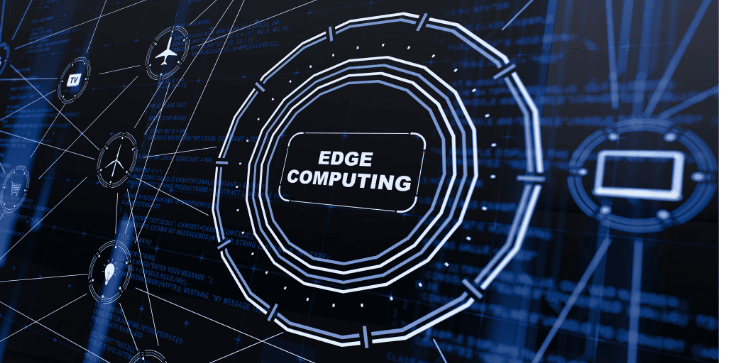One of the technological innovations that is becoming increasingly popular and integral to modern IT architecture is edge computing. This technology provides an innovative solution to address the various challenges faced by traditional computing systems, particularly related to bandwidth and the processing of large amounts of data.
What is Edge Computing?

Edge computing is a computing paradigm where data processing is carried out closer to the data source itself, at the “edge” of the network, rather than relying on centralized data centers or the cloud. In this model, data generated by devices such as sensors, cameras, IoT (Internet of Things) devices, or mobile devices does not need to be sent to central servers for processing. Instead, data is processed locally, near its source, which reduces dependence on internet networks and minimizes latency caused by transmitting data over long distances.
The Role in Modern IT Architecture
With the growth of IoT technology, the number of devices connected to the internet is increasing, generating vast and ever-expanding volumes of data. Traditional computing systems that rely on the cloud or centralized data centers to process this data may face challenges in terms of latency, bandwidth, and scalability. This is where edge computing plays a critical role.

-
Reducing Latency
Cloud-based computing systems often struggle with latency, as sending data from a device to a central data center takes significant time, especially when transmitting large amounts of data. Edge computing eliminates this delay by processing data closer to its source, drastically reducing transfer times to centralized servers. This capability is vital for applications requiring real-time responses, such as autonomous vehicles, security systems, and industrial processes that depend on sensors to monitor machinery and production
-
Bandwidth Efficiency
Sending all data generated by IoT devices or sensors to the cloud or a central data center can strain network bandwidth and increase operational costs. With edge computing, only relevant and necessary data is sent to the data center, while other data processing occurs locally. This reduces bandwidth usage and minimizes the need for fast, stable internet connections.
-
Faster and Real-Time Data Processing
-
Scalability and Flexibility
In traditional IT systems relying on the cloud, expanding capacity to handle larger data volumes often requires significant investment in data center infrastructure and internet bandwidth. With edge computing, computational capacity can be scaled more flexibly by adding more edge devices, without relying entirely on centralized data centers. This provides easier scalability at a lower cost.
-
Data Security and Privacy
Sending data to the cloud or centralized data centers often raises concerns about security and privacy. Data transmitted over the internet can be susceptible to hacking or eavesdropping. With edge computing, data is processed and stored closer to the user or device, reducing the risk of exposure while being transmitted over the network. Additionally, edge computing enables the implementation of stricter, localized security policies, enhancing protection for sensitive data.
Read More : how-hyperautomation-is-revolutionizing-it-operations
Applications Across Various Industries
EC has broad applications across various sectors, with industries increasingly relying on this technology to improve operational efficiency and create better user experiences. Some major applications of edge computing include:
- Manufacturing Industry
In manufacturing, edge computing monitors and analyzes data from sensors on machines or production equipment. Local processing detects technical issues early, preventing major problems and minimizing downtime or losses. - Autonomous Vehicles
Autonomous vehicles require real-time data processing to make quick decisions based on information from sensors, cameras, and radar. Edge computing lets vehicles process data locally, enabling quick responses to changing road conditions or traffic situations. - Healthcare and Medicine
- Smart Cities
Edge computing processes data from smart devices like streetlights, cameras, and transport systems in smart cities. Local processing enables efficient responses, such as adjusting traffic lights or quickly detecting emergencies.
Challenges in Implementing Edge Computing
Edge computing offers many benefits, but it also presents several challenges that require attention:
-
Simplifying Infrastructure Complexity
Organizations must distribute computing infrastructure across multiple locations, which complicates management and maintenance. Teams must configure and manage each edge device meticulously to maintain optimal performance.
-
Enhancing Data Security and Management
Edge computing strengthens security by minimizing data exposure during transmission, but it introduces new challenges in protecting and managing data stored on edge devices. Securing these devices becomes critical to prevent leaks or attacks.
-
Overcoming Resource Limitations
Edge devices, despite their power, often face constraints in computational capacity, storage, and power. Processing large or complex data can push these limits, making it essential to design edge devices tailored to the specific demands of their applications.
EC revolutionizes modern IT architecture by reducing latency, saving bandwidth, and enabling real-time data processing. This technology delivers numerous benefits across industries, including manufacturing, healthcare, and autonomous vehicles. However, managing infrastructure, addressing security issues, and overcoming resource limitations remain challenges.
As technology evolves and adoption expands, edge computing will increasingly shape the future of more efficient and responsive IT systems.





